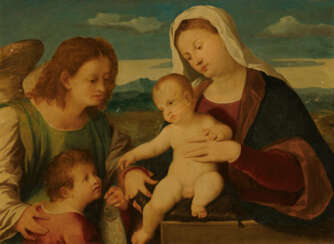jacopo negretti (palma, il vecchio) (1480 - 1528)

Iacopo Negretti, best known as Jacopo or Giacomo Palma il Giovane or simply Palma Giovane ("Young Palma"), was an Italian painter from Venice and a notable exponent of the Venetian school. After Tintoretto's death (1594), Palma became Venice's dominant artist perpetuating his style. Outside Venice, he received numerous commissions in the area of Bergamo, then part of the Venetian Domini di Terraferma, and in Central Europe, most prominently from the connoisseur emperor Rudolph II in Prague. Rejecting Mannerism in the 1580s, he embraced a reformist naturalism.[6] He varied the ingeniously synthesised amalgam according to subject matter and patrons' own eclectic and conservative tastes, with "virtuoso skill and a facile intelligence". Palma il Giovane went on to organize his own, large studio which he used to produce a repetitive series of religious and allegorical pictures that can be found throughout the territory of the Venetian Republic.


Jacopo Palma the Elder, born in 1480, was an illustrious Italian painter whose work left an indelible mark on the Venetian Renaissance. Renowned for his vibrant colors, dramatic compositions, and adept storytelling, Palma the Elder was a master of both religious and secular themes, embodying the splendor of Venice in his canvases.
Known for his profound influence on the development of Venetian painting, Palma's art is celebrated for its dynamic use of light and shadow, a characteristic that would come to define the Venetian style. His ability to infuse scenes with emotional depth and realism drew viewers into his narratives, making his works compelling for both contemporary audiences and modern viewers.
Among his most notable works are his altarpieces, which grace many of Venice's storied churches, showcasing his skill in depicting sacred subjects with reverence and majesty. His portraits and mythological scenes are equally esteemed, housed in some of the world's most prestigious museums and galleries. These pieces not only highlight his technical prowess but also his versatility as an artist.
For collectors and experts in art and antiques, Jacopo Palma the Elder represents a pivotal figure whose contributions to the Renaissance continue to captivate and inspire. His paintings offer a window into the rich cultural and artistic milieu of early 16th-century Venice, making them highly sought after for their beauty and historical significance.
To discover more about Jacopo Palma the Elder and to stay updated on opportunities to view or acquire his works, signing up for updates is a must. This subscription will ensure you're informed about the latest exhibitions, sales, and auctions related to this master's oeuvre, enriching your understanding and appreciation of Venetian art.







